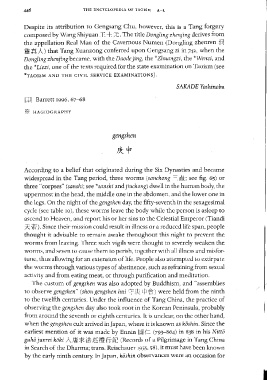Page 486 - The Encyclopedia of Taoism v1_A-L
P. 486
446 THE ENCYCLOPEDIA OF TAOISM A-L
Despite its attribution to Gengsang Chu, however, this is a Tang forgery
composed by Wang Shiyuan =[ ±JC. The title Dongling zhenjing derives from
the appellation Real Man of the Cavernous Numen (Dongling zhenren ?Iii]
m~ A) that Tang Xuanzong conferred upon Gengsang zi in 742, when the
Dongling zhenjing became, with the Daode jing, the *Zhuangzi, the *Wenzi, and
the *Liezi, one of the texts required for the state examination on Taoism (see
*TAOISM AND THE CIVIL SERVICE EXAMINATIONS).
SAKADE Yoshinobu
W Barrett 1996, 67-68
* HAGIOGRAPHY
gengshen
According to a belief that originated during the Six Dynasties and became
widespread in the Tang period, three worms (sanchong = ilIiIi.; see fig. 65) or
three "corpses" (sans hi; see *sanshi andjiuchong) dwell in the human body, the
uppermost in the head, the middle one in the abdomen, and the lower one in
the legs. On the night of the gengshen day, the fifty-seventh in the sexagesimal
cycle (see table 10), these worms leave the body while the person is asleep to
ascend to Heaven, and report his or her sins to the Celestial Emperor (Tiandi
7( $). Since their mission could result in illness or a reduced life span, people
thought it advisable to remain awake throughout this night to prevent the
worms from leaving. Three such vigils were thought to severely weaken the
worms, and seven to cause them to perish, together with all illness and misfor-
tune, thus allowing for an extension of life. People also attempted to extirpate
the worms through various types of abstinence, such as refraining from sexual
activity and from eating meat, or through purification and meditation.
The custom of gengshen was also adopted by Buddhism, and "assemblies
to observe gengshen" (shou gengshen hui 1'IJt ffJ W!) were held from the ninth
to the twelfth centuries. Under the influence of Tang China, the practice of
observing the gengshen day also took root in the Korean Peninsula, probably
from around the seventh or eighth centuries. It is unclear, on the other hand,
when the gengshen cult arrived in Japan, where it is known as koshin. Since the
earliest mention of it was made by Ennin IJ:i) 1= (793-864) in 838 in his Nitto
guho junrei koki A J! * {t ~ :ft fT tie. (Records of a Pilgrimage in Tang China
in Search of the Dharma; trans. Reischauer 1955, 58), it must have been known
by the early ninth century. In Japan, koshin observances were an occasion for

